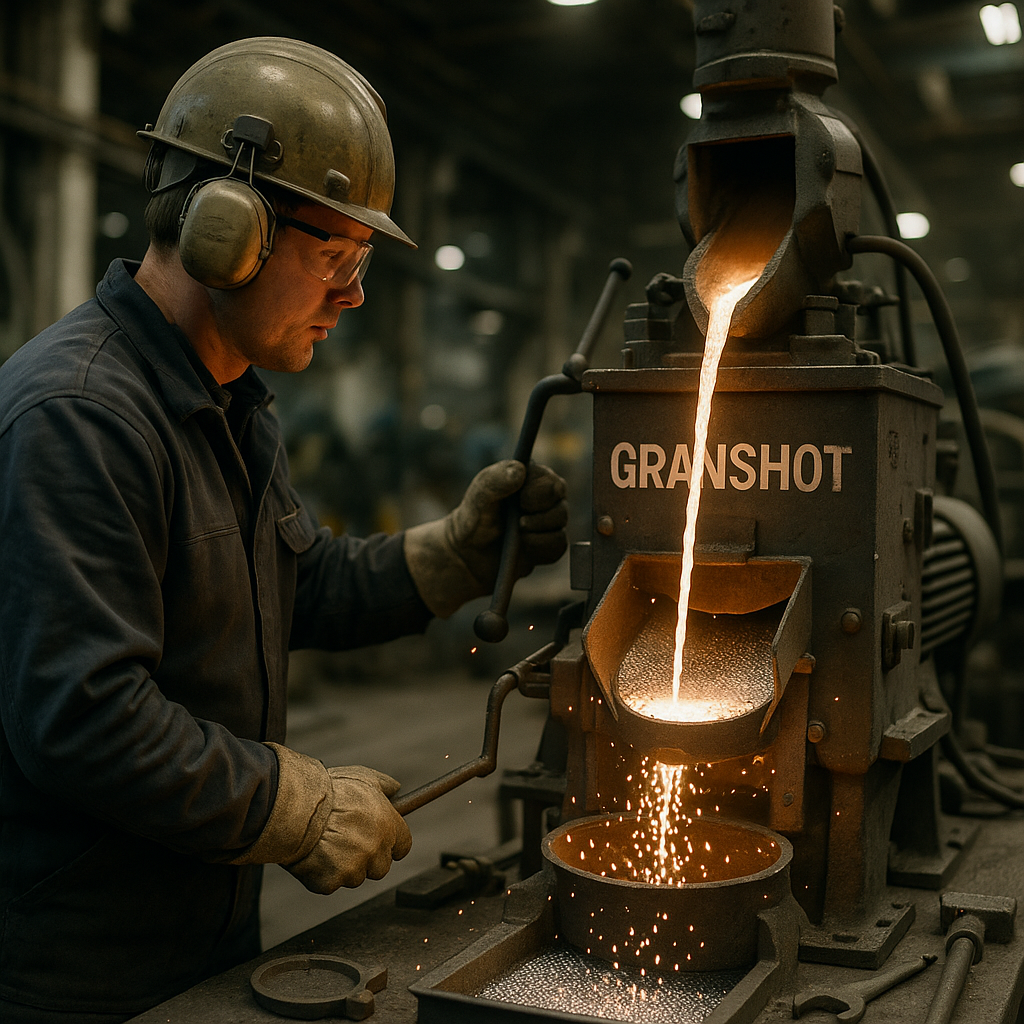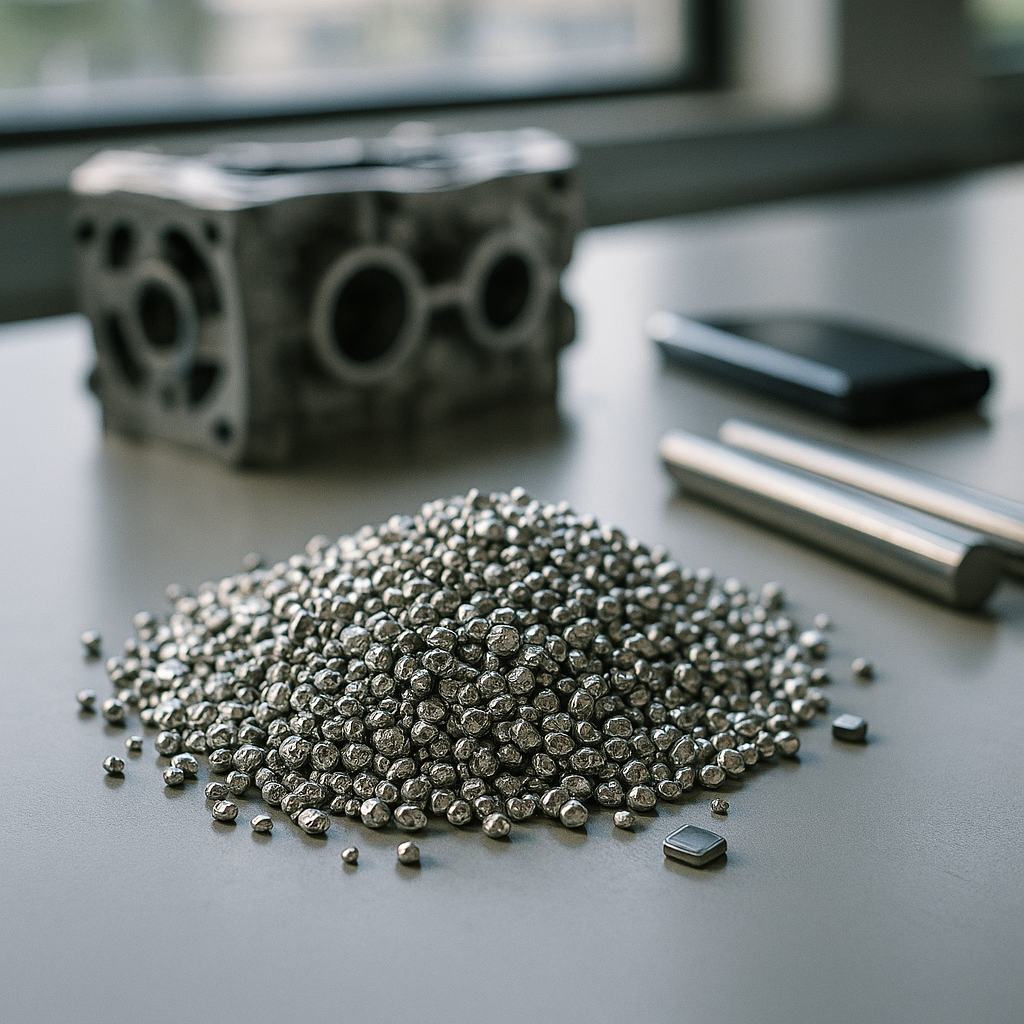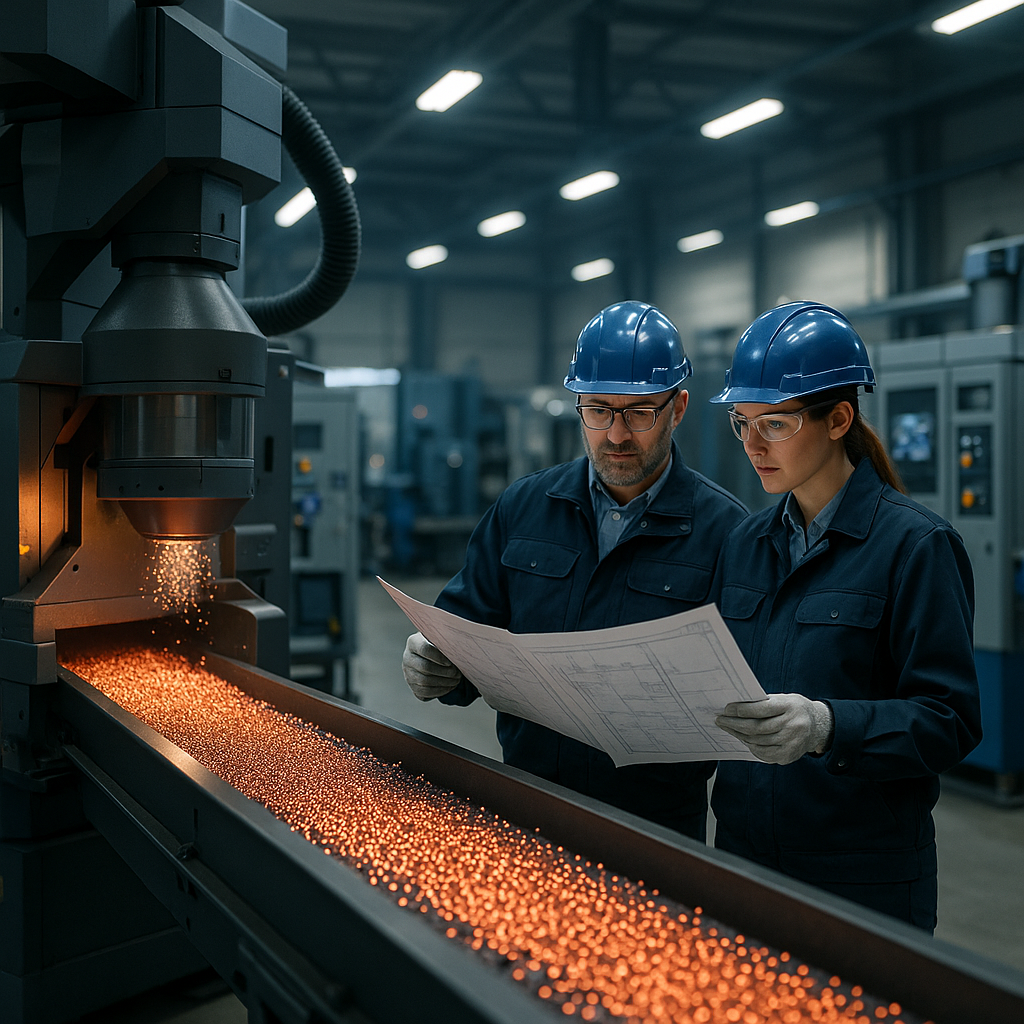5901 Botham Jean Blvd, Dallas, TX 75215
Metal Granulation Process: How Liquid Metal Becomes Granules
October 1, 2025The metal granulation process transforms liquid metal into solid granules through rapid cooling. When molten metal is poured into water, it instantly solidifies into small, irregular particles. This efficient method is a key technique in modern metal processing operations.
Metal granulation offers a practical solution for handling excess liquid metals in industrial settings. It is particularly valuable in integrated steelmaking, where facilities need to manage surplus liquid pig iron. The resulting granules are uniform, easy to transport, and prepared for use in various applications.
The transformation from liquid to solid takes only seconds. Water provides immediate cooling and solidification, producing granules with characteristics ideal for material handling systems. This rapid conversion preserves the metal’s chemical properties while changing its physical form to something more manageable.
How Does the GRANSHOT Metal Granulator Work?

The GRANSHOT metal granulator uses a high-capacity water granulation system to transform liquid metal into solid granules through immediate solidification. The process begins when liquid metal is poured from a ladle into a tundish positioned above a granulation tank filled with water. As the metal flows through the tundish nozzle, it strikes a specifically designed ceramic sprayhead.
This impact splinters the liquid metal into droplets that fall into the water bath, where they rapidly cool and solidify into granules. Within 30 seconds, the metal changes from its molten state to solid granules, eliminating traditional casting, crushing, and sieving processes.
At the bottom of the granulation tank, the solidified granules move through a water ejector system to a dewatering screen. Here, the granules are separated from the water and can be immediately transported via conveyor belts for storage or further processing.
Core Components of the GRANSHOT System
The GRANSHOT granulation system consists of several key components working together for efficient processing. The tundish controls the metal flow rate with its specialized nozzle, while the ceramic sprayhead optimizes droplet formation. The water-filled granulation tank offers a cooling medium, and the ejector system manages granule discharge.
The process water follows a cycle through a hot well where heat is managed by cooling towers or heat exchangers before returning to the cold well. This controlled circulation ensures optimal cooling capacity throughout the granulation process.
Production Capacity and Efficiency
The GRANSHOT granulator delivers impressive production metrics valuable for industrial metal processing:
- Processing capacity of up to 360 tons of metal per hour
- Nearly 100% process yield with minimal material loss
- Production of ready-to-use granules in 30 seconds
- Reduced operational costs by eliminating multiple processing steps
- Minimal oxide formation and high metallurgical quality
- High bulk density of the final product
The granulated metal retains a chemical composition nearly identical to the original liquid metal. The granules, typically ranging from 3-50mm, have a deformed spherical shape ideal for handling, storage, and dosage systems in downstream processes.
GRANSHOT technology can be applied to various metals, including pig iron, ferro-alloys (such as FeNi, FeMn, FeSi, FeCr), steel, and other metals like silver, copper, and aluminum. This versatility makes it valuable across various metallurgical industries.
What Are the Applications of Metal Granulation?

Metal granulation has evolved into a versatile process with significant applications across multiple industries. This efficient solidification method transforms liquid metals into solid granules with unique properties, making them ideal for various industrial uses.
Integrated Steelmaking
In integrated steelmaking facilities, metal granulation is crucial for handling excess iron production. When blast furnaces produce more hot metal than downstream operations can process, granulation units convert this excess into granulated pig iron (GPI).
This separation allows blast furnaces to operate optimally without interruptions, reducing coke requirements and extending furnace life. At facilities like SSAB in Oxelösund, Sweden, a 240-ton per hour granulation unit enables continuous granulation of all blast furnace output during steel plant maintenance.
The granulated iron produced is ideal for internal use in Basic Oxygen Furnaces (BOF) or for shipping to external Electric Arc Furnace (EAF) operators, offering a valuable alternative to scrap metal.
Ferroalloy Production
For ferroalloy producers, granulation is a standard operation suitable for most metals. Companies manufacturing ferronickel, ferrochrome, and other specialty alloys use granulation to create products with superior characteristics compared to traditionally cast and crushed materials.
The granulated ferroalloys offer advantages such as chemical homogeneity, minimal oxide content, low fines content, and excellent feeding properties due to their uniform size and shape. These qualities make them preferable for metallurgical processes, providing compact storage, easy handling, and precise dosage capabilities.
The GRANSHOT process offers ferroalloy producers a practical and economical way to handle liquid metal, featuring low operational and maintenance costs and metal yields approaching 100%.
Metal Recycling Applications
The metal recycling industry is increasingly adopting granulation technology to process recycled liquid metals. As collection systems improve and environmental regulations tighten, more valuable metals are being recycled.
Granulation effectively handles recycled liquid metal from sources like metallurgical industry dust, waste electrical and electronic equipment (WEEE), and hazardous waste, creating manageable products suitable for transport and further use.
For recyclers working with scrap metal, advanced granulation technologies enhance processing efficiency. The process can effectively transform complex metal waste streams into uniform, high-quality granules that melt quickly and integrate well into new metal products.
Beyond these major applications, metal granulation is used in casting operations, where clean and well-defined iron units facilitate weighing and charging operations. The technology continues to gain adoption as manufacturers recognize its efficiency, environmental benefits, and ability to produce high-quality metallurgical products.
What Are the Benefits of Metal Granulation?
Metal granulation transforms molten metal into uniform granules through rapid cooling. This process offers substantial benefits in handling, processing, and environmental impact. Let’s explore the specific advantages that make granulation increasingly valuable in modern recycling and manufacturing operations.
Superior Material Quality
The rapid solidification during granulation creates metal granules with exceptional characteristics. The process delivers homogeneous granules with consistent composition throughout, unlike traditional casting methods, which can lead to element segregation.
The quick cooling results in granules with minimal oxide content, enhancing purity and metallurgical properties. When reintroduced into manufacturing processes, these granules dissolve and melt more rapidly than larger metal pieces, saving both time and energy.
The uniform size and composition ensure predictable behavior in subsequent processing steps. This consistency is particularly valuable in industries requiring precise alloy formulations, such as automotive manufacturing and aerospace applications.
Enhanced Material Handling
The physical properties of metal granules provide significant handling advantages over traditional metal forms. Their deformed spherical shape makes them ideal for automated material handling systems. The granules flow smoothly through conveyors, can be easily moved with magnets, and are compatible with various loading methods, including front-end loaders and bin systems.
Granules also boast high bulk density, making storage more space-efficient compared to irregularly shaped scrap. Their free-flowing nature eliminates many challenges associated with bulky metal scrap, reducing labor requirements and improving operational efficiency.
- Compatible with conveyor belts for continuous processing
- Easily manipulated with magnets for sorting and movement
- Suitable for automated handling systems
- Efficient storage due to high bulk density
- Minimal risk of equipment damage during handling
Environmental Advantages
Metal granulation is a significant improvement over traditional solidification methods from an environmental perspective. The process produces little to no fume emissions, unlike methods like beaching or pig casting, which generate substantial dust and air pollution.
Water-based granulation systems can be designed with closed-loop recycling, minimizing water consumption and preventing contamination. Modern granulation equipment requires minimal land use and can often be installed within existing facilities, reducing the environmental footprint.
The process consumes less energy compared to alternative solidification methods, translating to lower carbon emissions across the metal processing lifecycle. For recycling operations, this efficiency supports sustainability goals while improving operational economics.
Transport and Logistics Benefits
Metal granules offer substantial advantages for transportation logistics. Their uniform shape and high density optimize space utilization in shipping containers and vehicles, allowing more material to be transported per shipment and reducing the overall carbon footprint.
Granules are inert during shipping and storage, eliminating concerns about oxidation or degradation over time. This stability ensures that material quality remains consistent from production to end use, regardless of transportation distances or storage duration.
The manageable form of granules simplifies loading and unloading operations, reducing handling time and minimizing the risk of workplace injuries associated with moving awkward scrap metal pieces.
By combining superior material properties with handling efficiency and environmental benefits, metal granulation delivers value throughout the entire supply chain. From recyclers to manufacturers, the advantages of this process make it an increasingly important technology in sustainable metal management.
Conclusion: The Future of Metal Granulation

Metal granulation technology has become a cornerstone of modern metallurgy, offering efficient and versatile solutions for processing liquid metals across various industrial applications. In this article, we’ve explored how advanced systems like GRANSHOT provide precise control over particle size and cooling rates while maintaining high production efficiency. These innovations have transformed how industries handle molten metals, creating valuable opportunities for both primary production and recycling operations.
As global environmental regulations become more stringent, the importance of metal granulation continues to grow. The technology’s ability to create uniform granules with controlled properties makes it invaluable for recycling operations that recover metals from waste streams. Granulation processes significantly reduce energy consumption compared to traditional metal processing methods. This efficiency, combined with the ability to produce high-quality outputs from lower-grade input materials, positions granulation technology at the center of sustainable metallurgical practices moving forward.
For assistance with implementing advanced metal granulation solutions for your recycling needs, contact Okon Recycling at 214-717-4083.
